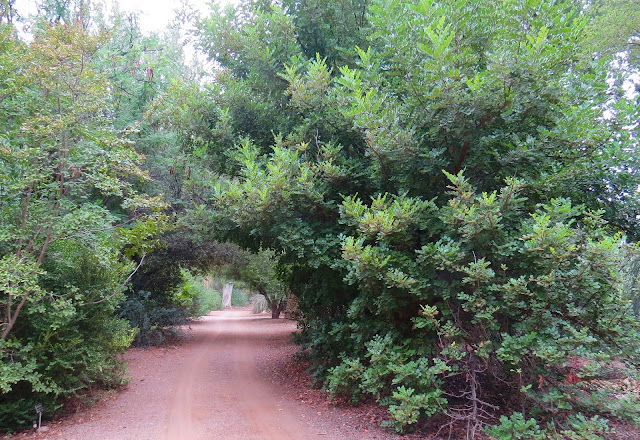Thursday, September 10, 2015
To strengthen my right leg and bring flexibility to my foot and ankle after being in a cast for two months post-bunion surgery, I’ve been taking physical therapy sessions several times a week until yesterday - when I felt good enough to continue the exercises on my own.
This morning’s overcast sky was gray/black as if it wanted to rain, but the last time I was at the Arboretum I hadn’t been able to complete the loop trail and it was bugging me so I went despite the threat of rain that, here in the desert, is frequently more threat than real.
I’m not sure walking long distances to look at birds qualifies as a specific therapy, but I put in 3.7 miles (in four hours) today at Boyce Thompson Arboretum (BTA) which means my foot and toe (with its plate) are working well.
Arriving just as the gate opened at 6:00 a.m., I began birding familiar desert species immediately as I headed up toward Ayer Lake. Walking at about one mile per hour is my general speed for birding large areas like this but I did do a few stops under thatched-roof ramadas when raindrops fell. No rain, no drizzle, just intermittent drops of rain that felt good on my body but I needed to protect my camera, in particular. My binoculars are waterproof but I don’t like to smear the lenses so I tucked in a few times until the drops stopped.
Turkey Vultures roost at the Arboretum. With no sun, they were all perched like statues on the ridge rocks below Picket Post Mountain. I counted 92 but didn’t take photos of all of them.
 |
| About 1/3 of all the Turkey Vultures perches on the wide rim rocks |
After passing Ayer Lake and the Mansion, the trail follows Queen Creek (no water today) past the Herb Garden and other special plantings.
 |
| Pomegranate plants can be found at various locations at the Arboretum |
While there were still a few migrating warblers foraging (MacGillivray’s and Townsend’s), the bird that fascinated me the most was the Warbling Vireo. Not specifically a western bird, it is very widespread throughout the U.S.A., although I wasn’t familiar with it until I moved to Arizona. Still, even on a good day, I might find one or two at this location (usually tracked down after hearing its unique song) but today they were throughout the Arboretum on every trail I took. No singing from any of them. With so many foraging on berries and bugs I felt sure I’d get a good photo. Not as hyper-active as most warblers, the vireos are a step slower but still too quick for me with their abrupt movements. The birds, seeming to sense the camera lens as soon as I focused, moved deeper into the trees. Its pale plumage is very plain and on this dark-cloud morning, its back appeared more gray/brown than greenish-gray. It’s best ID marker is its pale white halo around its dark eye.
Why so abundant today? Migration. All the Warbling Vireos in North American are heading to Mexico and Central America for the winter and won’t show up at BTA again until March or April.
 |
| My best shot of the Warbling Vireo |
In this same stretch of habitat between the trail and Queen Creek were several Black-headed Grosbeaks.
 |
| Female: based on its variant lemon-yellow breast instead of the deeper burnt-orange of the msle |
Western Tanagers, cardinals and wrens shared this same habitat with the warblers and grosbeaks.
At the Demonstration Garden, Bell's Vireos were very vocal while staying hidden. Cactus and fall flowers were pleasant.
 |
| Sacred Datura (Jimson Weed) |
If the sun had been out, the Sacred Datura would have all been closed up by this time (about 9:30). You can see that some already are but they will open again in the evening. It doesn't smell particularly good which may be a good thing because all parts of the plant are toxic and may be lethal. The roots were brewed and consumed by Native Americans in the Southwest to induce visions in religious ceremonies.
Two hummingbirds maintained a battle for the feeder in the Demonstration Garden: an Anna's and a Broad-billed.
 |
| Anna's Hummingbird |
 |
| Broad-billed Hummingbird |
Exiting BTA through the Hummingbird Garden, butterflies were plentiful. Although I don't know this one, I've placed a potential name on it based on online photos.
 |
| Queen Butterfly
BTA offers lots more than birds for enjoyment!
By the time I left, the Turkey Vultures had lifted into the sky but were flying low, not circling in deep kettles as usual. Having completed the full circuit trail plus many additional ones boosted my confidence for having regained even more strength and stamina. The dark day provided lots of light for me!
* * *
View this checklist online at http://ebird.org/ebird/view/checklist?subID=S24972057
|




Yes. Definitely a Queen Butterfly. That is yet another magical place here in Arizona. I wish my gardens looked like that over here:) I get maybe one day? to work on them. The migrants must be out of control there right now.....a warbler haven!
ReplyDeleteThanks, Chris.
ReplyDeleteYes, it was wonderful to be surrounded by so much life out there.